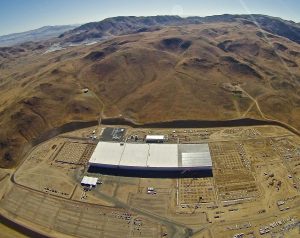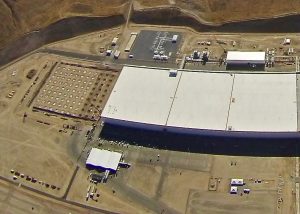News
Highlights from Tesla’s Gigafactory Media Event
Tesla kicked off its Gigafactory Tour on Tuesday, July 26 with a media event. We’re providing the best curated Tweets from today’s event followed by a live Tweet from the official Gigafactory Grand Opening party scheduled for this Fiday, July 29.
Follow us on Twitter and join us Live from the Tesla Gigafactory!
July 25: Tesla Gigafactory Media Event (Pacific Time):
- 12:00-12:30 PM: Arrival at the Gigafactory and intro
- 12:30- 2:30 PM: Exterior and Interior tours
- 3:00-4:00 PM: Remarks and Q&A with Elon Musk and JB Straubel
- 4:15/30 PM: Shuttle departs Gigafactory
We’ll provide an update in a follow up post with results from the Q&A
Elon Musk and JB Straubel take the stage for Q&A
Alongside Elon and JB is an executive from Panasonic.
Elon Musk just arrived to talk Gigafactory pic.twitter.com/URTSoMP6e2
— Marco della Cava (@marcodellacava) July 26, 2016
Q&A with Elon Musk & JB Straubel coming up
Tesla #gigafactory tour complete. Now awaiting Elon Musk and JB Straubel. Musk running a bit late we are told. pic.twitter.com/pl5Z6LcCA4
— Marco della Cava (@marcodellacava) July 26, 2016
Tesla Gigafactory robots in action
https://twitter.com/danielsparks/status/758058708895092736
https://twitter.com/danielsparks/status/758058583426682880
Top 6 tidbits about Tesla’s Gigafactory revealed through building permits
Tesla continues its expansion on the Gigafactory as seen at outer areas of the main plant where steel construction beams are being put into place.
Section B Prime of Tesla #gigafactory – only a few days into construction as pace here quickens pic.twitter.com/3E69qgVUGM
— Marco della Cava (@marcodellacava) July 26, 2016
Tesla describes their relationship with Panasonic
Media was chaperoned to a no-photography-allowed section within the plant that housed proprietary equipment from Panasonic.
https://twitter.com/ByBenSpillman/status/758048060077289472
https://twitter.com/ByBenSpillman/status/758061212345085952
Tesla is already assembling Powerwall units
Inside Tesla's #gigafactory – where Tesla Powerwall battery storage units are now being built. pic.twitter.com/PpAAdKSF9C
— Marco della Cava (@marcodellacava) July 26, 2016
Area within the Gigafactory where battery cells will be produced
https://twitter.com/danielsparks/status/758044716273315841
Water treatment facility located on the east side behind the main entrance to the Gigafactory
https://twitter.com/ByBenSpillman/status/758038584393732096
The Gigafactory looks small by comparison to its expansive surroundings
https://twitter.com/danielsparks/status/758036769904263168
Tesla’s Gigafactory occupies a relatively small footprint within the overall 3200 acres of land purchased
- Tesla Gigafactory, July 24, 2016
- A newly perched white tent is seen near the entrance to the Gigafactory
This is just 20% of total #Gigafactory. 1.9 million sq feet of planned 10M = 107 football fields pic.twitter.com/kp9uteZMrN
— Marco della Cava (@marcodellacava) July 26, 2016
Miniature models of the Gigafactory office space and production floor
https://twitter.com/danielsparks/status/758039972121186304
A model of the Gigafactory is seen in the lobby showing robots in action on the production floor.
A “you are here” label reveals that the current size of the Gigafactory is only 14% of what it will ultimately be.
Model of Tesla #gigafactory production floor pic.twitter.com/Y5sToPJZKy
— Marco della Cava (@marcodellacava) July 26, 2016
https://twitter.com/ByBenSpillman/status/758021392272986112
Entrance to the Gigafactory
Tesla CEO Elon Musk will address reporters here at #gigafactory later today. Stay with @usatodaytech pic.twitter.com/fT95tZOeEy
— Marco della Cava (@marcodellacava) July 26, 2016
Tesla giving test drives in a Model S P90D before taking groups to tour the interior of the Gigafactory
Killing time before exterior tour at Tesla #gigafactory with test "flights" of Model S pic.twitter.com/HFKRr8pu4t
— Marco della Cava (@marcodellacava) July 26, 2016
Greeted by a beautiful Tesla Model 3 at the entrance of the Gigafactory
https://twitter.com/danielsparks/status/758020744747941888
Media making a pitstop at the security gate on Electric Avenue before heading into the Gigafactory
https://twitter.com/danielsparks/status/758015650560249856
New aerial photos of the Gigafactory taken on Sunday, July 24 shows a security guard shack located on the main road leading into the property.

Elon Musk
Elon Musk and Tesla AI Director share insights after empty driver seat Robotaxi rides
The executives’ unoccupied tests hint at the rapid progress of Tesla’s unsupervised Robotaxi efforts.

Tesla CEO Elon Musk and AI Director Ashok Elluswamy celebrated Christmas Eve by sharing personal experiences with Robotaxi vehicles that had no safety monitor or occupant in the driver’s seat. Musk described the system’s “perfect driving” around Austin, while Elluswamy posted video from the back seat, calling it “an amazing experience.”
The executives’ unoccupied tests hint at the rapid progress of Tesla’s unsupervised Robotaxi efforts.
Elon and Ashok’s firsthand Robotaxi insights
Prior to Musk and the Tesla AI Director’s posts, sightings of unmanned Teslas navigating public roads were widely shared on social media. One such vehicle was spotted in Austin, Texas, which Elon Musk acknowleged by stating that “Testing is underway with no occupants in the car.”
Based on his Christmas Eve post, Musk seemed to have tested an unmanned Tesla himself. “A Tesla with no safety monitor in the car and me sitting in the passenger seat took me all around Austin on Sunday with perfect driving,” Musk wrote in his post.
Elluswamy responded with a 2-minute video showing himself in the rear of an unmanned Tesla. The video featured the vehicle’s empty front seats, as well as its smooth handling through real-world traffic. He captioned his video with the words, “It’s an amazing experience!”
Towards Unsupervised operations
During an xAI Hackathon earlier this month, Elon Musk mentioned that Tesla owed be removing Safety Monitors from its Robotaxis in Austin in just three weeks. “Unsupervised is pretty much solved at this point. So there will be Tesla Robotaxis operating in Austin with no one in them. Not even anyone in the passenger seat in about three weeks,” he said. Musk echoed similar estimates at the 2025 Annual Shareholder Meeting and the Q3 2025 earnings call.
Considering the insights that were posted Musk and Elluswamy, it does appear that Tesla is working hard towards operating its Robotaxis with no safety monitors. This is quite impressive considering that the service was launched just earlier this year.
Elon Musk
Starlink passes 9 million active customers just weeks after hitting 8 million
The milestone highlights the accelerating growth of Starlink, which has now been adding over 20,000 new users per day.

SpaceX’s Starlink satellite internet service has continued its rapid global expansion, surpassing 9 million active customers just weeks after crossing the 8 million mark.
The milestone highlights the accelerating growth of Starlink, which has now been adding over 20,000 new users per day.
9 million customers
In a post on X, SpaceX stated that Starlink now serves over 9 million active users across 155 countries, territories, and markets. The company reached 8 million customers in early November, meaning it added roughly 1 million subscribers in under seven weeks, or about 21,275 new users on average per day.
“Starlink is connecting more than 9M active customers with high-speed internet across 155 countries, territories, and many other markets,” Starlink wrote in a post on its official X account. SpaceX President Gwynne Shotwell also celebrated the milestone on X. “A huge thank you to all of our customers and congrats to the Starlink team for such an incredible product,” she wrote.
That growth rate reflects both rising demand for broadband in underserved regions and Starlink’s expanding satellite constellation, which now includes more than 9,000 low-Earth-orbit satellites designed to deliver high-speed, low-latency internet worldwide.
Starlink’s momentum
Starlink’s momentum has been building up. SpaceX reported 4.6 million Starlink customers in December 2024, followed by 7 million by August 2025, and 8 million customers in November. Independent data also suggests Starlink usage is rising sharply, with Cloudflare reporting that global web traffic from Starlink users more than doubled in 2025, as noted in an Insider report.
Starlink’s momentum is increasingly tied to SpaceX’s broader financial outlook. Elon Musk has said the satellite network is “by far” the company’s largest revenue driver, and reports suggest SpaceX may be positioning itself for an initial public offering as soon as next year, with valuations estimated as high as $1.5 trillion. Musk has also suggested in the past that Starlink could have its own IPO in the future.
News
NVIDIA Director of Robotics: Tesla FSD v14 is the first AI to pass the “Physical Turing Test”
After testing FSD v14, Fan stated that his experience with FSD felt magical at first, but it soon started to feel like a routine.

NVIDIA Director of Robotics Jim Fan has praised Tesla’s Full Self-Driving (Supervised) v14 as the first AI to pass what he described as a “Physical Turing Test.”
After testing FSD v14, Fan stated that his experience with FSD felt magical at first, but it soon started to feel like a routine. And just like smartphones today, removing it now would “actively hurt.”
Jim Fan’s hands-on FSD v14 impressions
Fan, a leading researcher in embodied AI who is currently solving Physical AI at NVIDIA and spearheading the company’s Project GR00T initiative, noted that he actually was late to the Tesla game. He was, however, one of the first to try out FSD v14.
“I was very late to own a Tesla but among the earliest to try out FSD v14. It’s perhaps the first time I experience an AI that passes the Physical Turing Test: after a long day at work, you press a button, lay back, and couldn’t tell if a neural net or a human drove you home,” Fan wrote in a post on X.
Fan added: “Despite knowing exactly how robot learning works, I still find it magical watching the steering wheel turn by itself. First it feels surreal, next it becomes routine. Then, like the smartphone, taking it away actively hurts. This is how humanity gets rewired and glued to god-like technologies.”
The Physical Turing Test
The original Turing Test was conceived by Alan Turing in 1950, and it was aimed at determining if a machine could exhibit behavior that is equivalent to or indistinguishable from a human. By focusing on text-based conversations, the original Turing Test set a high bar for natural language processing and machine learning.
This test has been passed by today’s large language models. However, the capability to converse in a humanlike manner is a completely different challenge from performing real-world problem-solving or physical interactions. Thus, Fan introduced the Physical Turing Test, which challenges AI systems to demonstrate intelligence through physical actions.
Based on Fan’s comments, Tesla has demonstrated these intelligent physical actions with FSD v14. Elon Musk agreed with the NVIDIA executive, stating in a post on X that with FSD v14, “you can sense the sentience maturing.” Musk also praised Tesla AI, calling it the best “real-world AI” today.











